Like an escalator that only knows how to go up, the market for colored diamonds has been rising rapidly. But instead of a smooth, steady ascent, colored diamonds have leapt upward in huge increments. Prices per carat have doubled, even during the gloomiest worldwide economic conditions. Someone, it seems, always has the money and the desire to buy these compelling gemstones.
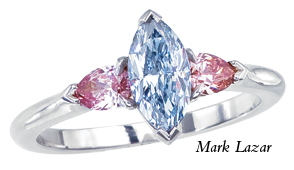 Whether the sales are through retail outlets, online, wholesale or at auction, one reason for the escalating prices is that supply can’t match the demand — particularly at the very highest end of the market, where intensity of color is prized. With more people becoming aware of the beauty and rarity of fine fancy color diamonds, it’s not surprising that prices are increasing faster than any miner can find a new source and sink a shaft.
Whether the sales are through retail outlets, online, wholesale or at auction, one reason for the escalating prices is that supply can’t match the demand — particularly at the very highest end of the market, where intensity of color is prized. With more people becoming aware of the beauty and rarity of fine fancy color diamonds, it’s not surprising that prices are increasing faster than any miner can find a new source and sink a shaft.
Limited Supply, Great Demand
In a market where pricing is a closely held secret, tied to the absolute uniqueness of most colored diamonds, the auction market provides a stunningly open price venue. Presale estimates signal the auction experts’ expectations, which are based on past sales, rarity and general economic conditions. When these estimates are exceeded — wildly — they make headlines and bring out buyers and sellers, both groups eager to take part in the next sale.
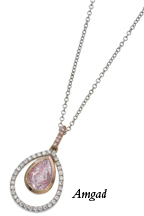 Potential buyers form an ever-growing market that seems to have no limit. Even among those in the trade, the scarcity of extremely fine, intense or vivid colored diamonds creates a buying frenzy. There may not be that many sharks in this particular ocean, but each one is determined to win the prize. When Laurence Graff paid $24.3 million for the Wittelsbach Diamond on December 10, 2008, he not only bought a piece of history, he outbid Aleks Paul of Essex Global Trading to do so. On November 16, 2010, Graff found himself competing against three other bidders when he bought a 24.78-carat fancy intense pink diamond for $46.16 million at Sotheby’s, setting a new world auction record for a diamond and any jewel.
Potential buyers form an ever-growing market that seems to have no limit. Even among those in the trade, the scarcity of extremely fine, intense or vivid colored diamonds creates a buying frenzy. There may not be that many sharks in this particular ocean, but each one is determined to win the prize. When Laurence Graff paid $24.3 million for the Wittelsbach Diamond on December 10, 2008, he not only bought a piece of history, he outbid Aleks Paul of Essex Global Trading to do so. On November 16, 2010, Graff found himself competing against three other bidders when he bought a 24.78-carat fancy intense pink diamond for $46.16 million at Sotheby’s, setting a new world auction record for a diamond and any jewel.
Graff is likely not in a hurry to sell the recut stone now known as the Wittelsbach-Graff. Once a unique colored stone is sold, no matter how high the price, it’s gone. According to Henri Barguirdjian, president and chief executive officer (CEO) of Graff USA, “Fine colored diamonds are beyond scarce. To get your hands on a fine pink or a fine blue is a big deal these days. The price is higher than previous transactions. In hindsight, yesterday’s buy is a bargain.” The escalation of prices is evident in a singular fine pink sold by Christie’s on December 1, 2009, in Hong Kong, for $10,776,660, more than $2 million a carat. Barguirdjian recalls selling that same stone four and a half years earlier in New York for $3 million.
Barguirdjian sees the supply and pricing of colored stones as a double dilemma. No matter how profitable the selling price, each sale depletes the available supply. “We have sold a few important stones privately at Graff this year. We thought we had good prices. Then Mr. Graff said, ‘Now that you have sold them, what are you going to do to replace them?’
We have probably the largest resources of anyone. I have five or six U.S. clients looking for a very special pink or blue.
There is no limit on price; people understand about rarity. This is happening in all areas of art, including jewelry.”
Rahul Kadakia, head of jewelry at Christie’s Americas, says, “Over the past ten years, the shortage has become deeper and deeper if you want a great, important, colored diamond of any size and intensity. In 2000, there was more supply and not everybody fully understood how rare the stones were. China was not buying in that area, the Russians were not in. The Middle East was buying yellow and white. Now, every part of the market is looking for a 5-carat vivid blue or pink. Today, you have China and the Russians who have bought a lot of colored diamonds over the past four years, and a constant demand from the United States and Europe. Prices went through the roof.”
Orange at the Top
This past June, Christie’s New York sold a fancy intense orangy-pink diamond of 10.19 carats for $2,322,500, or $228,000 per carat. The stone was sold to William Goldberg Company. Goldberg made headlines in 1997 by cutting a rare piece of orange rough that became known as the Pumpkin diamond.
That 5.54-carat stone was purchased by Harry Winston Company at auction in 1997 for $1.3 million. Then, it was considered an expensive novelty. Today, it would be considered a bargain.
According to Elan Ben-David of Ishay Ben-David, a longtime dealer in colored diamonds based in New York City, “In my opinion, a pure vivid orange is the rarest. Even a purplish red is not as rare, although it commands the highest price per carat. Overnight, I can have a dozen purplish red stones from 20 points to 1 carat at $400,000 to $500,000 a carat, but not orange. I have sold two orange stones. I have one in stock and I don’t know of any other. I think there are only ten in the whole world. When you see a pure orange next to yellow-orange, you understand why it is so beautiful.” And, of course, it’s also so rare. A pure orange, with no modifying colors such as brown or yellow, is much more difficult to find. Take, for example, the 7.67-carat, cut-cornered, rectangular fancy intense pinkish orange diamond set in a ring that was sold in April 2010 at Sotheby’s New York for $3.11 million.
A look at the Ishay Ben-David website is a tour through the rainbow of fancy color diamonds. Currently, the site offers a truly rare 1.40-carat radiant fancy vivid purplish pink diamond. The website is not an industry-only place to shop; it requires no password. A few stones are shown with prices, but most of the rare gems are “price on request.” In spite of the growing market in other parts of the world, Ben-David says, “The majority of my business is still in the United States.”
For Ben-David personally, changes in scarcity and pricing have been dramatic during his eight years in the family business. “Even five years ago, blue was rare, but pinks were easier to find than they are now. Any size blue is desirable now, from 20 points up, any tone, even as an accent in a piece of jewelry. For stones over 20 points, the price has more than doubled in five years. Even a 1-carat vivid blue is close to double. We used to buy them for stock; now they tie up so much money. An intense blue diamond of 20 points, we sell for $100,000 a carat.
For a 1-carat stone, the price is $250,000 a carat.” Kadakia warns not to look for a new supply of blue diamonds any time soon. “Blues came out of the most important mine De Beers had for a long time.” The Cullinan mine, previously known as the Premier mine through most of its 100-plus-year history, consistently produced significant blue diamonds. “The De Beers Millennium blue came out of
Cullinan ten years ago,” Kadakia points out. “Since then, nothing significant or as large as that has been found.” The Cullinan mine is now owned and operated by Petra Diamonds, but Kadakia doesn’t expect the supply of blues to increase. “They get one great blue a year. In the time it takes to find a 10-carat blue,” he adds, “there are fifty 10-carat D flawless diamonds. A 1-carat polished blue — just a fancy blue — is perhaps one in every 200,000 stones. For a vivid blue, it’s one in ten million.”
In May 2009, the sum of $9,488,754 was paid for a 7.03-carat vivid blue cushion-shaped diamond at Sotheby’s Geneva, setting a record price of $1,349,752 per carat. That blue, unsurprisingly, came from the Cullinan mine under its new owner, Petra. By comparison, at the same sale, Sotheby’s sold a fancy intense pink diamond weighing 5.29 carats for $2,048,508. Blue triumphs pink in scarcity.
Canaries Sing
One of the reasons for the scarcity of certain colored diamonds is the peculiar nature of color in diamonds. Bruno Scarselli, whose astonishing five-stone Olympia Diamond Collection on exhibit at the American Museum of Natural History inNew York City was the culmination of 40 years of collecting, specializes in canary yellow diamonds, from 1 carat up to 50 carats — and above. With New York City–based Scarselli Diamonds’ strength in 5-carat to 25-carat stones, he can put five 10-carat yellow diamonds in front of a customer at any given time. But don’t look for those yellows to be round.
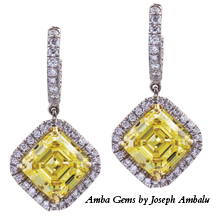 “You don’t cut a yellow like you would cut a blue or green. You must treat the different colors differently,” Scarselli explains. “The radiant cut was designed to create more color — the most color you can obtain. It was designed to create the best sparkle and scintillation. You can have a slightly yellow diamond; the radiant will bring out the most luster and color. If you take the same diamond and cut it to a round brilliant, the color would disappear.” This accounts for the absolute scarcity of very fine, round yellow diamonds. A round yellow can only be cut from a rough that is intensely saturated with color.
“You don’t cut a yellow like you would cut a blue or green. You must treat the different colors differently,” Scarselli explains. “The radiant cut was designed to create more color — the most color you can obtain. It was designed to create the best sparkle and scintillation. You can have a slightly yellow diamond; the radiant will bring out the most luster and color. If you take the same diamond and cut it to a round brilliant, the color would disappear.” This accounts for the absolute scarcity of very fine, round yellow diamonds. A round yellow can only be cut from a rough that is intensely saturated with color.
While there is greater interest in colored diamonds than five years ago, Scarselli says, “There is far greater interest in Europe and Asia, particularly India.” But Scarselli brought together two 27-carat vivid yellow diamonds from very different sources for a recent sale. “One diamond had been created into a European emerald cut. It had been bought and then returned because of the financial woes of the customer. The other we created from a rough that was very difficult. We felt if we wanted to work on the outer surface, we would be able to keep all the color with the largest possible volume. We created four long facets and four narrow facets, making a rhomboid cut. We then rearranged the pavilion of the European-cut stone to give the same optical effect.” The ultimate customer was a Norwegian seeking to make an investment. “He is someone who has been buying sizable types of diamonds, and putting them in a safe,” Scarselli adds.
Yellows are more widely available, and make less of a financial demand on both the seller and the buyer, Scarselli says. He notes that a 5-carat fancy yellow diamond at the retail market would fetch $65,000 while, in comparison, a 5-carat pink would go for $1 million, and a 5-carat blue would take the buyer into the $2.25 million to $2.5 million range. “It’s far easier to find ten buyers for the $65,000 yellow, where there might be one buyer for the pink or blue.” That is also a function of supply; there are many more yellows to offer.
Scarselli sees a correlation between the availability of yellows and the range of tones in the yellow family. “There are more tones and more secondary tones,” he says. “Whereas in blue, there are only grayish and greenish stones; in pink, there are brown, orange, purple and purplish. There are more ways to market brown diamonds. There is a story and romance.”
At the September 28, 2010, Sotheby’s auction in New York, yellow diamonds were priced below those of fine white stones. A private collector bought a 17.97-carat, VVS1, fancy intense yellow diamond set in a ring for $482,500, or $26,850 per carat; while a second ring, likewise set with a VVS2, fancy intense yellow diamond weighing 10.29 carats, fetched $254,500, or $24,733 per carat.
The biggest and most consistent supplier of yellow diamonds is the Ellendale mine in Western Australia. Bought by Gem Diamonds in 2007, the mine claims to produce approximately 50 percent of the world’s supply of fancy and vivid yellow diamonds. In the first half of 2010, the mine sold 77,198 carats at an average price of $434. Its most prominent customer is Tiffany, where the average price per carat was $2,588. That is undoubtedly going to increase, as Gem Diamonds has just negotiated a 25 percent price increase in the yellow diamonds it sells to the famous retailer. Tiffany’s interest in yellow seems almost predestined. While the retailer launched its yellow diamond collection only this year, the iconic 90-carat Tiffany Diamond, always on view in the flagship Fifth Avenue store, is a fancy canary yellow stone.
In The Pink
The most reliable supply of pink diamonds continues to come from Rio Tinto’s Argyle mine in Australia and they are offered at a yearly tender. Jean-Marc Lieberherr, the company’s general manager, explains, “Rio Tinto’s Argyle diamond mine is the world’s only consistent producer of rare pink diamonds but even then, less than one-tenth of 1 percent of the Argyle production is pink diamonds. Of every million carats of rough diamonds produced at the Argyle mine, only 1 carat is suitable for sale in the Argyle Pink Diamonds Tender.”
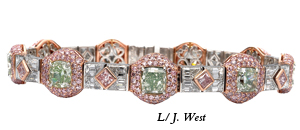 The mine has been producing pink diamonds for the past 25 years, with only 40 to 60 stones offered at the tender each year. The number of stones varies, depending on
The mine has been producing pink diamonds for the past 25 years, with only 40 to 60 stones offered at the tender each year. The number of stones varies, depending on
production, Lieberherr says. “In most cases, these stones are above half a carat in size and of exceptional hue and intensity.” The 2010 tender comprised 55 stones for a total weight of 46.44 carats. “This year’s tender is notable for its unparalleled color saturation, setting a new benchmark with many more ‘vivid’ pinks than previous years,” says Lieberherr. Included was a 2.02-carat round brilliant, fancy vivid purplish pink diamond. While not wanting to reveal prices, he adds, “Since the first
Argyle Pink Diamonds Tender in 1985, pink diamond prices have increased exponentially. This price growth is a reflection of the fundamental economics of pink diamonds — increasing demand for a truly scarce product. Never before, and never since, has there been a diamond mine that consistently produced rare pink diamonds like the Argyle diamond mine.” That consistency does not change as the mining operation goes deeper into the earth.
On the supply side, Lieberherr says, “the chances of any future mine discovery replicating the unique properties of the Argyle mine is extremely low. Even if another deposit of pink diamond-bearing ore is discovered, it takes on average ten years for a mine to proceed from discovery to production. On the demand side, we are continuing to see strong growth in demand for Argyle pink diamonds from both the mature and emerging markets. Last year, we took the tender to Mumbai for the first time…this year, the tender had its inaugural showcasing in Mainland China.”
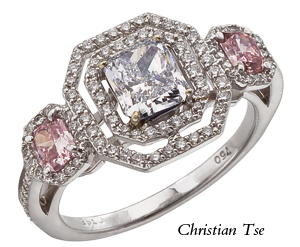 The Asian market for colored diamonds is growing at a rapid pace, sometimes in spite of considerable difficulties and delays. According to Scarselli, “China is impenetrable. There are issues with imports, taxation, currencies. Everything that is shown in Mainland China is transacted in Hong Kong.” But he sees other parts of Asia as rising markets.
The Asian market for colored diamonds is growing at a rapid pace, sometimes in spite of considerable difficulties and delays. According to Scarselli, “China is impenetrable. There are issues with imports, taxation, currencies. Everything that is shown in Mainland China is transacted in Hong Kong.” But he sees other parts of Asia as rising markets.
“In the Philippines, Laos, Vietnam, Brunei, there is incredible development. Singapore is now going head-to-head with Hong Kong. The Chinese don’t ever rest. Their work ethic is tremendous.”
Champagne Dreams
While most of the attention goes to the blockbuster stones that fetch millions, there is a substantial and consistent market for diamonds whose body color was once considered a hindrance to their sale. When the Argyle mine started marketing its pale yellow to deep brown diamonds under the romantic name “Champagne Diamonds,” these stones became fashionable — and salable. Argyle, now owned by Rio Tinto, says $5 billion of jewelry set with champagne diamonds is sold annually around the world. The lightest shades, once known in the trade as Cape diamonds, now carry fanciful color descriptions such as “light straw.” Argyle invented its own color grading scale for the stones, ranging from C1 and C2 for light champagne up to C7 for fancy cognac.
Interest in colored diamonds will only increase in the coming years. The request for color has been tempered by the present economic situation, Scarselli says. “I mostly sell to other dealers, rarely to retailers. But there is a bit more awareness of color out there because of stars on the red carpet, at the Oscars.” While interest and an appetite for colored diamonds will increase, the supply will not keep pace. One doesn’t need a crystal ball to predict increasingly higher prices for these rare treasures of the earth.
Article from the Rapaport Magazine - December 2010. To subscribe click here.